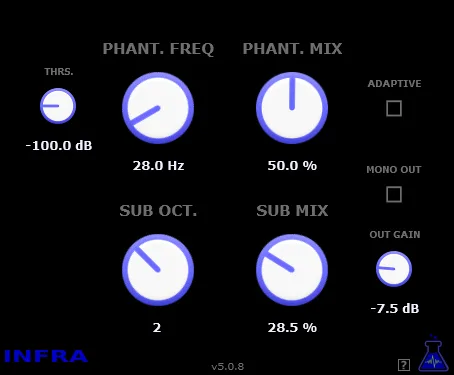Noisebud Fletchy-Muncher: Test Your Mix for Club PA Loudness
Every sound engineer knows how important it is to check their mix at different loudness levels and on different playback systems. A mix that sounds perfect at moderate volume in studio monitors may fall apart on a loud club system or simply sound completely different. This is due to the peculiarities of human hearing, described by the Fletcher-Munson curves. Our hearing is less sensitive to low and high frequencies at low volume levels and becomes more linear at high levels. The Noisebud Fletchy-Muncher plugin is designed specifically to help you predict how your mix will sound at very high volume, even before you leave the studio.
What are Fletcher-Munson curves and why are they important?
Equal loudness curves, developed by Fletcher and Munson in the 1930s, show how loud a sound must be at different frequencies for a person to perceive it with the same loudness as a 1 kHz tone. The main conclusion is that at low volume levels, we need significantly more physical loudness (in decibels) at low and high frequencies for them to seem as loud as the mid-range frequencies. As the overall loudness increases, these curves become flatter, meaning that our hearing perceives the balance of frequencies more evenly. This explains why mixes often sound “thin” or “dull” at low volume, but “rich” and “bright” at high, or vice versa – “loud” and “full” at low, but “harsh” and “tiring” at high.
How does Fletchy-Muncher work?
Fletchy-Muncher simulates the difference in perception of frequency balance between moderate volume (approximately 60-70 dB) and very high volume (about 100 dB). This difference reproduces the effect of “equalization” of perception that occurs when you go from a studio listening level to the level of a loud concert sound. The plugin is designed to be placed last in the effects chain on your master channel or mix bus.
Using the plugin:
- Insert Fletchy-Muncher in the last position in your effects chain on the master bus.
- Listen to your mix at a moderate volume.
- Move the plugin’s knob from “Flat” (in which it does absolutely nothing) to “Default”.
- Carefully listen to how the frequency balance has changed.
In the “Default” position, the plugin applies a filter that simulates how your mix would be perceived at a volume of about 100 dB, if you mixed it at a volume of 60-70 dB. If, with Fletchy-Muncher enabled in the “Default” position, your mix sounds harsh, overly bright, or unpleasant resonances or sibilants appear, this is a sign that these problems are present in your mix, but were hidden by the peculiarity of hearing at a lower volume.
Correcting Problems
If Fletchy-Muncher has detected problems at the “loud” simulation level, you need to go back to the mixing or mastering process and make the appropriate corrections.
- Use an equalizer (EQ) to reduce or soften excessive brightness or harshness in the upper range.
- Apply a multi-band compressor (Multiband Compressor) to control certain problematic frequency areas that become aggressive at high volumes.
- Use a de-esser (De-esser) to tame harsh sibilants in vocals.
- Review other tools and methods that could help smooth the frequency response at high volumes.
Important note:
Don’t overdo the corrections! The purpose of Fletchy-Muncher is to detect problems that appear at loud volumes. If you overcompensate for these problems, your mix may sound dull, muffled, or lacking “air” when listening at moderate or low volume. Find a balance.
Remember that Fletchy-Muncher is a tool for analyzing and checking. Before the final export (bounce) of your mix or master, be sure to disable or remove the plugin from the effects chain. It only simulates perception and is not an effect that should remain in the final audio file.
Noisebud Fletchy-Muncher is a useful tool for anyone who wants to create a mix that will sound good not only in the studio, but also on any playback system, especially at high volume. Use it as a “litmus test” to identify hidden problems in the frequency balance of your track.



